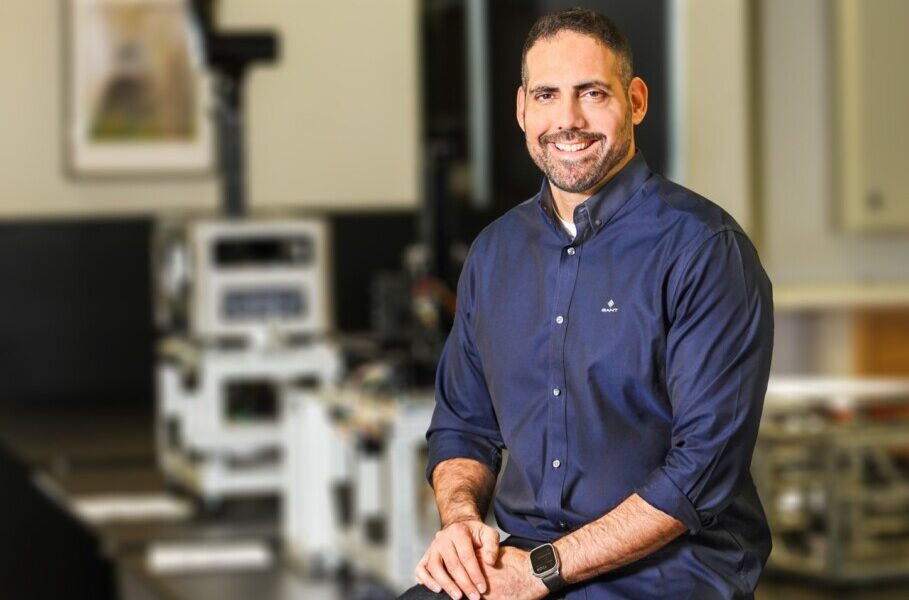Joseph Nathan, MD, MSc is the Co-Founder, President and Chief Medical Officer at ForSight Robotics. Dr. Nathan has over 20 years of experience in medical innovation. Previously, he directed healthcare commercialization at the Technion – Israel Institute of Technology, and served as Director of New Ventures for the Technion’s Alfred Mann Institute, a $100M joint venture incubating medical startups. Dr. Nathan earned a BSc in Biotechnology Engineering, MSc in Industrial Engineering, and MD, all from the Technion. Dr. Nathan also completed 3 years of ophthalmic surgery residence at Rambam Hospital.
ForSight Robotics is pioneering advancements in eye surgery with a mission to improve global access to high-quality ophthalmic care. Millions of people worldwide experience poor vision and face barriers to excellent surgical treatment. ForSight Robotics aims to address these challenges with ORYOM™, the first hybrid intraocular robotic ophthalmic platform, designed to enhance and expand the capabilities of ophthalmic surgery on a global scale.
What inspired you to co-found ForSight Robotics, and how did your background as both a physician and engineer shape the vision for the company?
While studying to be an engineer at the Technion, Israel’s Institute of Technology, I was fascinated by the intricacies of multidisciplinary technologies and how it can help patients. After receiving my BSc and MSc in engineering, I pursued my MD degree followed by three years of residency in ophthalmic surgery. While in residency, I learned first-hand the high level of precision required of surgeons to operate effectively and the toll these highly technical surgeries takes on surgeons. I also found that it took decades to master the high level of skill needed to provide the most accurate surgical care, and often heard ophthalmic surgeons say that they “operate like robots” due to the repetitive nature of ophthalmic procedures, like the removal of cataracts. In ophthalmology, precision and accuracy are crucial to ensuring safe surgeries. With my engineering background and experience in the operating room, I knew there was a better way to deliver more accurate patient care, ensure better outcomes, and ease surgeon burnout. Thus, the idea for ForSight Robotics was born.
I knew we needed a strong founding team to bring this vision to life. I approached Professor Moshe Shoham, with whom I had worked during my time at the Technion and who had founded the robotics laboratory at both the Technion and at Columbia. As the founder of Mazor Robotics, he brings decades of technical knowledge and experience building advanced systems. We also partnered with robotics expert Daniel Glozman, PhD, who was one of Prof. Shoham’s first students, and together we founded ForSight Robotics.
Why did you choose ophthalmic surgery as the focus for ForSight Robotics, and how do you see robotics transforming this field in the next decade?
Globally, at least 1.1 billion people have preventable vision impairment, and within this patient group, cataracts are the leading condition causing impairment or blindness in over 600 million patients. Over 30 million cataract surgeries are performed annually, making them the most common procedure worldwide. In the US, there are 32M patients in need of surgery to address cataracts, yet only 11K surgeons are trained in this field, leaving a massive accessibility gap for patients in need of surgical care. Because of the global market need and our profound robotics expertise, we focused on building our ORYOM™ Platform (Hebrew for daylight)—the first robotic ophthalmic platform to treat cataract and other widespread eye diseases—to address this ongoing problem, expand ophthalmic surgery access, and close a growing surgical care gap.
Regarding transformation, the robotics industry is at an inflection point. AI and automation have accelerated the advancement of technology, and public perception of medical robots is at an all-time high. We see patients seeking advanced technological care, and surgeons preferring to use surgical robotics in other specialties – and there is also high interest from ophthalmologists who want their field to “catch up” with the technological advances they see in other specialties that have already had robotic surgery for years. Building on the growing momentum, ForSight has built an incredible team of technical experts and investors to help us reach our highest potential. This includes the recent addition of “the father of robotic surgery,” Dr. Fred Moll (founder of Intuitive Surgical), to our Board of Directors, our ongoing support from board advisor Rony Abovitz, founder of MAKO, leading ophthalmic surgeons that make up our Clinical Advisory Board, and our VC partners. The sky is the limit for the potential of medical robotics, and our vision is to harness the power of robotics, AI, and automation to transform the surgical robotics space.
ForSight Robotics aims to “democratize access to ophthalmic surgeries.” How do you define success in achieving this goal?
Ultimately, we will have reached our goal when the demand for ophthalmic surgeons eases, and robotic surgery is offered globally. To drive success, we are focused on three key metrics.
First, ophthalmic training time should be reduced, and the learning curve should be shortened. It takes at least 15 years for ophthalmic surgeons to achieve peak surgical performance. This is too long of a runway to address the growing demand for cataract and other eye surgeries in aging adults. With ForSight’s ORYOM™ Platform, surgeons can adopt the technology in a few sessions and operate with the platform shortly thereafter, thus significantly decreasing the learning time.
Second, two-thirds of ophthalmic surgeons experience physical health issues caused by poor ergonomics. Issues such as musculoskeletal, back, and neck pain lead to 15% of eye surgeons retiring early. ForSight’s ORYOM™ Platform scales down a surgeon’s hand movements, increasing accuracy and ergonomic comfort that decreases a surgeon’s cognitive and physical stress and fatigue, thus increasing their operating career.
Third, we aim to increase a provider’s surgical throughput by three times. Right now, a full cataract surgery from start to finish takes around 15 minutes. Surgeons work around the clock in the operating room to complete as many surgeries as possible in a given day to maximize their time in the operating room. ForSight’s ORYOM™ Platform decreases the overall procedure time, thus increasing the number of surgeries that can be completed in a single day and over time, increasing the number of cases that can be achieved.
Your technology is described as offering “superhuman” precision and scalability. Can you explain how AI and robotics enable this capability in practice?
Our robotic surgery platform enhances the operating process by utilizing AI-based algorithms and micromechanics to deliver micron-level precision. During the procedure, the platform provides actionable insights to surgeons through embedded sensors, cameras, and kinematics to improve overall surgical technique. ForSight’s ORYOM™ Platform is built with 14 degrees of freedom to deliver complete access for surgeons to reach every point with the human eye. Future iterations of the platform will allow for the performance of both anterior and posterior procedures, furthering ForSight’s vision and impact.
Robotics allows us to dial in on a specific movement and standardize it across all patients. By providing real-time 3D image guidance and augmentation of the procedures, surgeons can have a more holistic view of the procedure and improve their execution. In addition to real-time analytics, we’ve scaled down the hand movements required for the procedure, reduced the hand tremors, and incorporated no-fly zones to increase overall surgical accuracy and precision.
What makes the ORYOM™ Platform unique compared to other robotic surgery solutions currently available?
The ORYOM™ Platform is the first robotic ophthalmic platform for cataract and other widespread eye diseases, which provides significant advantages for both patients and surgeons. To address the physical stress surgeons experience during surgery and prevent early retirement due to physical issues, we focused on creating ergonomic features that address these stressors, including screen/table positioning, how a surgeon handles the tools, and built-in neutral positioning. We’ve also embedded haptic capabilities, including vibrations, resistance, and other sensory factors, into the technology for an enhanced surgical experience.
Other unique features of the ORYOM™ Platform include reducing the overall procedure time, which enables practitioners to operate on more patients in a single day and perform more cataract surgeries over time. Additionally, to ensure mass adoption amongst surgeons, we’ve created a training program that allows practitioners to train on the platform and operate with the technology with a significantly shorter learning curve, while maintaining high surgical accuracy.
How does ForSight Robotics plan to address the disparity in access to eye surgeons between affluent and low-income countries?
As a global company, we aim to expand ophthalmic surgery for all. We are targeting the US market first because, historically, technology adopted in the US tends to lead to success in other markets. At the same time, we’re looking at countries such as India, China, and the Middle East which are investing in their healthcare systems to overcome the lack of infrastructure. By targeting these markets, we can expand access and resources to countries that have higher populations needing care. Further, by increasing a current surgeon’s capacity, we can expand access to a greater population of patients.
With cataracts being a leading cause of blindness globally, what is ForSight Robotics’ long-term vision for eradicating preventable blindness?
In creating the ORYOM™ Platform, our goal is to grow and scale our robotic surgery platform to reach more practitioners and in turn, more patients. The ORYOM™ Platform was developed from the ground up, ensuring that our robotic systems are built to reach every point within the eye. We are beginning by targeting cataract, the most common medical procedure with over 600M patients worldwide, and then seek to expand to address other eye diseases and tackle other procedures that demand high dexterity from surgeons. In the future, we will also advance automation in robotic surgery in order to increase global access to quality surgical eye care.
What role do partnerships with hospitals and medical professionals play in the adoption of the ORYOM™ Platform?
Collaboration with hospitals, clinics, and practitioners enables us to provide the best surgical care to vision-impaired patients. This year, Dr. Fred Moll, the founder of Intuitive Surgical, joined our board of directors to support ForSight’s next growth phase, including scaling the company globally. Working alongside Dr. Moll and our expert team, we are building strategic partnerships within the healthcare system to provide vision-saving ophthalmic surgery to patients.
As of February 2025, the ORYOM™ Platform has been optimized and validated by over two dozen surgeons who have successfully performed over 200 complete robotic cataract procedures on an animal eye model. We are working closely with leading ophthalmic surgeons worldwide to ensure that our technology answers surgeons’ needs.
What are your thoughts on Nvidia‘s and OpenAI‘s recent advancements in robotics, and how might these developments impact ForSight’s future?
It’s an exciting time to be a robotics founder. Recent announcements from Nvidia and OpenAI underscore how rapidly AI is transforming robotics and increasing investment across the industry. As robotic technology advances, AI and automation will continue to play a vital role in developing ForSight’s technology, with the goal of fully automating repetitive surgical tasks in the future.
Nvidia’s robotics are trained using large open-source LLMs along with millions of hours of simulations and real-world data. This is a huge leap forward in training machines on perceived environments for driving and humanoids, allowing embodied AI to progress faster. For surgical robotics, we will see an increased use of AI to analyze large amounts of real-world data while training future robotic systems in simulated environments.
All of these developments benefit the field of robotics as a whole, and will have a positive impact on the field of robotic surgery as well. The impressive speed at which these major companies are developing novel AI tech will have a net positive impact on so many industries, and will also improve our goals of delivering more effective and safer surgeries, faster.
Can you share any insights on how the integration of cognitive data analytics improves surgical outcomes with ORYOM™?
Overall, advanced technologies that are based on large data sets and AI analytics can provide surgeons with insights into their techniques, and offer new and optimized approaches by identifying patterns and understanding of the “big picture” that may not have been available previously. Cognitive data analytics learns from large data sets in order to provide real-time guidance – improving imaging feedback and decision-making to improve surgical precision. By analyzing real-time patient data, AI-based algorithms can provide the surgeon with patient-specific surgical optimization. This can improve accuracy and reduce the risk of errors that can occur in manual operations. In addition, pre- and post-op data analysis can provide tailored approaches for patients.
ForSight is working on studying large data sets to improve surgical precision with the ORYOM™ Platform. This is done by real-time image guidance, which can provide surgeons with a more comprehensive surgical picture and smaller details that may have been missed, along with other data analytics methods to improve training and execution, thus enhancing both the patient and surgeon experience.
Thank you for the great interview, readers who wish to learn more should visit ForSight Robotics.



